Professor Sir Nairn Wilson: ‘The Future of Dental Technology’
During his introduction to his presentation entitled ‘The Future of Dental Technology’ delivered from the Dental Technicians’ Hub at DTS on Saturday 18th May, Professor Sir Nairn Wilson expressed his pride at being invited to be an Ambassador for the Dental Technologists’ Association, explained his keen interest in the technologist profession, and urged his audience to apply for a DTA Fellowship, awarded in recognition of the importance and excellence of dental laboratory work in the UK.
What follows is an interpretation of Sir Nairn’s presentation, which, he pointed out, was his personal view and not that of any of the many organisations of which he is a member or supporter.

He revealed that his first experience of being a dental ‘mechanic’ was as a schoolboy at the in-house lab of his father’s (W. F. Wilson) single-handed dental practice. Sir Nairn was just 12-years-old. This experience stood him in good stead when he began his studies to become a dentist. In those days, one of the five years of undergraduate dental studies was largely devoted to training in dental technology. By the time Sir Nain qualified, he had produced and provided 52 sets of complete dentures, let alone large numbers of indirect restorations and partial dentures. After he became qualified, he continued to produce indirect restorations and dentures for his patients.
He maintained his interest in the technical side of his profession, and laments the fact that so little has been published about the development and history of dental technology, especially at the paucity of dental technology artefacts at the BDA museum, which is currently closed for refurbishment and is set to re-open at the end of 2024.
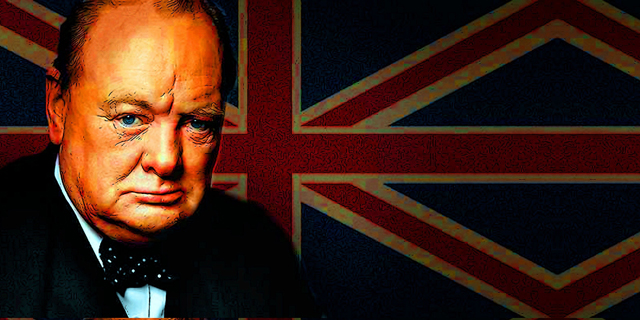
Why this interest in the history of dental technology? Sir Nairn quoted Winston Churchill’s 1948 speech to the British House of Commons, when the great statesman said: “Those that fail to learn from history are doomed to repeat it.” He then observed that it was Lord Kitchener during WW1 who realised that maintaining good oral health would help keep troops on the front line.
But the poor state of working-class mouths – no dental care for most of them – and the difficulties that the very basic army food presented, made the all-consuming pain of acute toothache all too common. When war broke out many of the working and lower-middle-class soldiers had very poor teeth – the result of too much sugar and too little dentistry. In some cases, teeth were in such a poor state that volunteers were rejected.
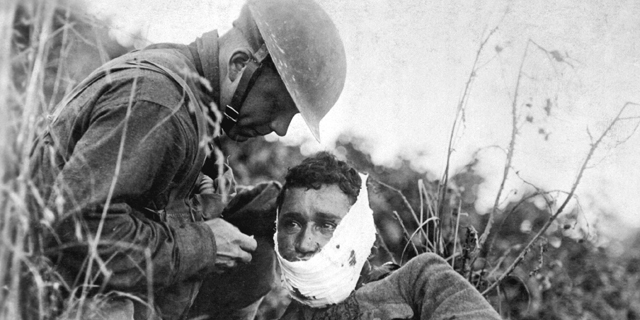
The state of the nation’s teeth even reached the pages of Punch. In August 1914 it published a cartoon of a disgruntled man at a recruiting office protesting to the MO who’d turned him away because of his rotten teeth: “Man, ye’re making a gran’ mistake. I’m no wanting to bite the Germans; I’m wanting to shoot ‘em.”
Joking aside, Sir Nairn urged his audience to record the history of dental technology in the UK, calling for volunteers to work with the BDA Museum and for technicians to join the Lindsay Society for the History of Dentistry (https://lindsaysociety.co.uk/) which ‘promotes interest, study and research into the history of every aspect of dentistry and aims to bring together people who share these interests’. (Editor’s note, yes, I am a member)
The Society, which works closely with the BDA and College of General Dentistry, is named after Lilian Lindsay (1871-1960), the first woman to qualify as a dentist in the UK and a leading dental historian. She became the BDA’s first female president in 1946.
A time of change
Sir Nairn observed that dentistry is in a dynamic state of flux and in these times of rapid change and development five years is a long time. How can we predict the future with any certainty? Who, just a few years ago, could have foreseen that, when making an impression, alginate would be replaced by intraoral scanners of ever-increasing sophistication. The digital workflow, including artificial intelligence (AI) is a growing presence in the clinic and the dental laboratory.
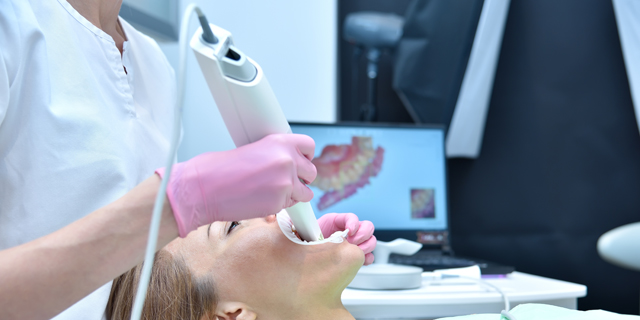
“If you think things are moving fast now,” he opined, “then hold onto your seats because the pace of change is going to increase. Digital workflow will become routine rather than the exception, with automatic updates ‘future proofing’ the technology as innovations continue apace.”
Production procedures at present tend to be remote, but Sir Nairn believes that situation will change with technologists returning to working in-house. A practice-based digital dental technologist would be a key member of the frontline dental team, perhaps working with the care coordinator to explain to the patient exactly what they can expect from the care they receive, and what the best outcome should be.
Yes, Sir Nairn used the word ‘care’ rather than ‘treatment’. He believes that ‘treatment’ sounds too interventive, too surgical. He thinks patients want to hear that we will ‘care’ for their oral health, not ‘treat’ the lack of it.
How will the new-style dental technologist work in-house? They might be freelance, an employee, or supplied by an agency. There are many effective models of employment that could be suitable to the technologists’ role in a modern digital capacity, without need of the sacks of gypsum that plastered every surface of the traditional lab. Today’s workbench is virtual, clean, and would easily fit into a modern, smart, hygienic dental practice.
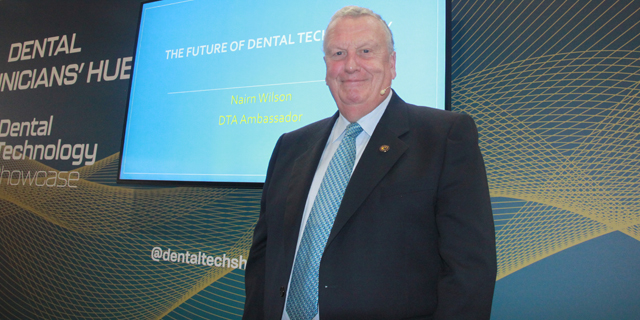
There are some 22 thousand dental practices in England alone. Sir Nairn put forward the concept of potentially 22 thousand technologists working in-house, drawn from the host of gamers already deeply embedded in the world of virtual reality. An IT expert – once given the rudiments of dental design methodology – may become an essential member of the dental team.
But, Sir Nairn asked, why not start from the other end? Take a technologist with all their hard-earned knowledge of a tooth’s anatomy and how it fits in the oral environment – and teach them to use the technology and AI already available to the lab – but with one essential caveat.
Why AI must remain a ‘tool’; and the need for a new curriculum
What is ‘best practice’ in dentistry? Ideal care must be based on the best available evidence, the knowledge, skills and acumen of the clinician, and the wishes of the patient. It must not become subject to the diktats of artificial intelligence. What works on an assembly line is not suitable for human care. Sir Nairn observed that it may become too easy to follow AI guidelines and lose sight of what best practice involves. AI is a useful tool but it must be kept under control.
This is true of CAD/CAM both in the laboratory and in the surgery. In fact, coming to terms with technical innovation – and the potential changing scope of practice created by new technology – drives a pressing need for a new curriculum when training every member of the dental team, something the GDC recognises. In Sir Nairn’s model for future education, the regulator wants to allow more flexibility for educators to develop curricula that better reflect the reality of the modern dental workplace.

A new curriculum for dental technologists might want to see things such as traditional removable prostheses and hand-crafted indirect restorations removed from the course work, except for maintenance and repair. Denture work could become the niche responsibility of clinical dental technicians, supported in the management of complex cases by specialists in prosthodontics.
So, if that comes out of the coursework, what comes in for the dental team? Computer science and IT/AI/virtual reality skills; data management and security; CAD/CAM and 3D printing, care coordination and planning, and electronic patient record systems etc. This means learning to use the technology to facilitate the team’s workflow and improve the patient experience. Dentistry has a history of embracing new technology, however, Sir Nairn warned, innovation must be evidence-based. It is not enough to ask, ‘Can we do it?’ The question is, ‘Should we do it?’ And how will it benefit the patient?
The future of dental practice calls for a strengthening of the academic base, more research into how care can be improved, and a better understanding of the interweaving strands of oral and systemic health leading to a firmer foundation upon which technological innovation can be built. Who could have foreseen the revelation that periodontal disease is linked to diabetes, heart disease, and even stroke? The latest research puts the mouth firmly back in the body, and there are calls for the dental team to be recognised as integral to primary care.
Academic organisations such as the College of General Dentistry (CGDent) – supported by associations such as the DTA – can help lay the metal for a clear career pathway for dental technologists, and in turn start attracting young people to the new dynamic profession that is dental technology in the 21st Century.
In summary what are we talking about?
• Learning lessons from documenting the history of dental technology in the UK, including recording what is happening in the laboratory right now.
• Designing a new forward-looking curriculum and encouraging new educational providers.
• Repositioning dental technology in dentistry, with technologists returning to be members of practice-based teams.
• Strengthening the academic base and research underpinning modern dental technology.
To the growing sound of applause from his appreciative audience, Sir Nairn concluded by saying: “Your destiny is in your hands. To quote Doc Brown from the iconic film Back to the Future ‘The future’s unwritten, it’s what we make of it.’ Right now, dental technology is pushing against an open door. It’s time to step through.”
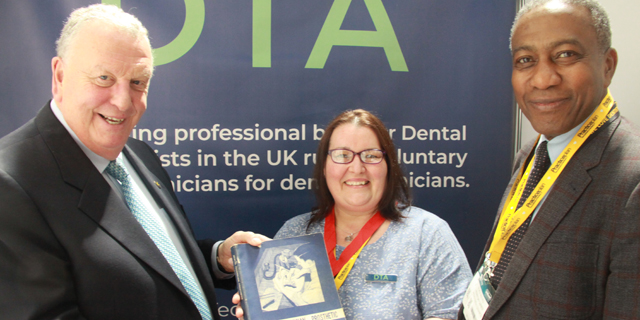
After speaking with members of his audience Sir Nairn was invited to the DTA stand where President Delroy Reeves and President Elect Jo Stevenson presented him with a book for the BDA library.
In an email to the association administration, he wrote: “The gift of the USA Naval Dental Technology Manual was greatly appreciated. What a thoughtful thing to give me. I will be donating the book to the BDA Library, suitably inscribed to record the event.
“If anyone in the DTA would like to 'pick up the gauntlet' to record the history of dental technology in the UK, I would be most pleased to work with them to research and record this important aspect of the history of dentistry.
“I suspect that whatever happened in the dental mechanics (technology) in the UK a 100-150 years ago was reflected across the Commonwealth, and possibly the rest of the world. It will be a great project to fully document the history.”





















